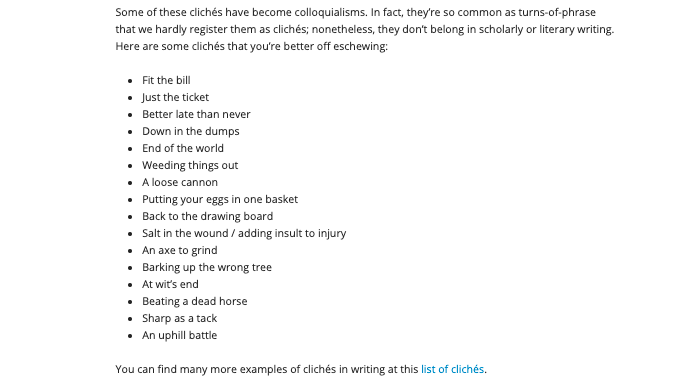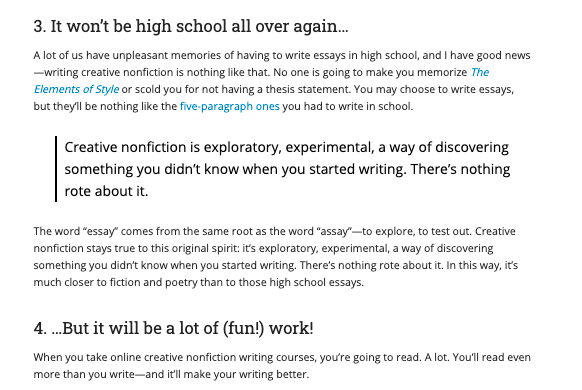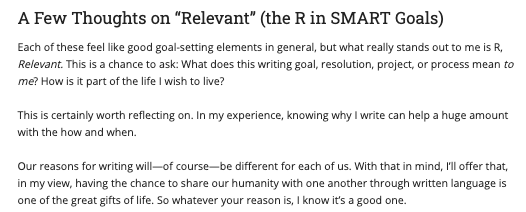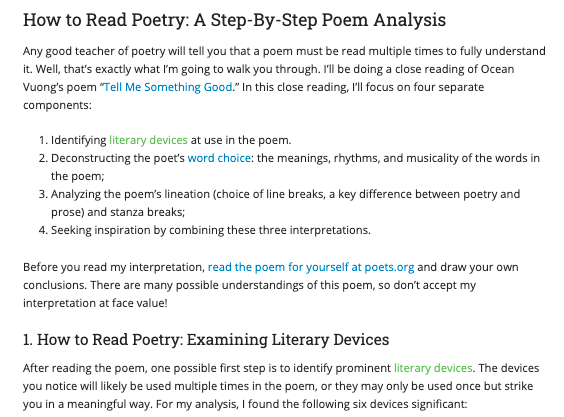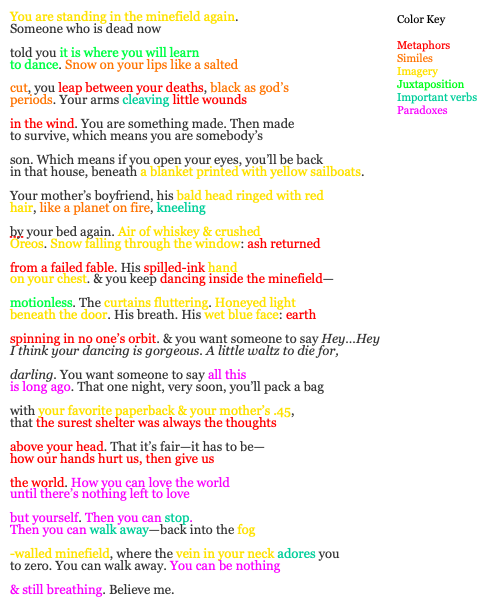Editorial Guidelines
General Info
Minimum Word Count: 1500
Writing level: Accessible to a general audience
Intent: Bringing more traffic to Writers.com; promoting certain courses
Tips for Writing on a Digital Platform
Effective blog content follows some specific patterns. Both search engines and blog readers are attracted to the following:
1. Lists
Lists help make information easier to process for the reader, and Google often shares lists in response to search queries.
There are two types of lists: numbered and unnumbered. Unnumbered, or bulleted, lists help present information using the fewest possible words, such as this list of clichés:
Numbered lists, by contrast, are a great way to organize sections in a text. Using numbered headers will help Google understand how your article is organized, and it will also make information easier for the reader to search. Here are some numbered headers in our article on CNF courses:
2. Short Paragraphs
Try to keep paragraphs to a maximum of three or four sentences. On the internet, readers tend to have shorter attention spans and to skim more. They tend to skip long paragraphs, and to simply navigate away from articles that are too dense.
The paragraphs in this section on SMART goals are of good length.
3. Regular Use of Headings
Most word processors let you partition an article using different leveled headings. These headings help piecemeal blog content for the reader, and they also help search engines understand the focus of your content.
The title of an article is always a Heading 1 (H1). Major subheadings are Heading 2 (H2), and subdivisions within those are Heading 3 (H3). These subheadings are another way to list content, too!
Take this example from our article on how to read poetry. The top header is an H2, and the numbered header is the first in a list of H3s.
As a general rule, try to have a H2 or H3 every 300-400 words. In these guidelines, “Tips for writing on a digital platform” is an H2, and the numbered sections are H3s.
4. Blockquotes
Rather than reading word-by-word, blog readers will often skim an article looking for major highlights. A blockquote is a great way of providing those highlights.
The indented texts in this article are blockquotes:
Blockquotes are difficult to format in word processors; they’re generally formatted through HTML or with the help of publishing tools in WordPress. You don’t need to worry about this formatting when you submit an article, but if you can highlight certain sentences that are good for blockquotes, that’s immensely helpful for us!
5. Pictures
Visual demonstrations of concepts can greatly improve an article’s readability and search engine performance. These aren’t essential, but if you can demonstrate an idea using graphs, highlights, or other visuals, do it!
For example, pictures are a great way to demonstrate what’s going on in a certain text. Recently, we used text highlights in our article on “how to read poetry like a poet,” which helped map the text in a colorful and appealing way.
6. Internal & External Links
Search engines like it when articles have links to other content, as it makes the article seem more researched and authoritative. Internal Links are links to other Writers.com content; External Links are outside of the Writers.com domain.
In the following screenshot, the links to books are external, whereas the link to an article at Writers.com is internal.
7. Emphasis
Using bold or italics can help emphasize important points in text, making them easier to read. As a style note, we tend to italicize text on Writers.com rather than bold it, and we try not to use too much emphasis, too often.
Search Engine Optimization
What is SEO?
The other important aspect of writing for the internet is performing Search Engine Optimization, or SEO. Articles that are better “optimized” for search engines will rank higher for relevant search queries, attracting more traffic to the blogpost.
When writing an article for Writers.com, we may send you certain keywords to target throughout the blogpost. These keywords are relevant & specific queries that many people search for, based on research from an SEO website called SEMRush. If an article uses these search queries frequently enough, it will start to attract web traffic from search engines. In other words, the article is optimized!
How to Read SEO Templates
Most content on the internet targets multiple keywords. To make it easier, we’ll do research on these keywords in advance and send an SEO template, like the one below:
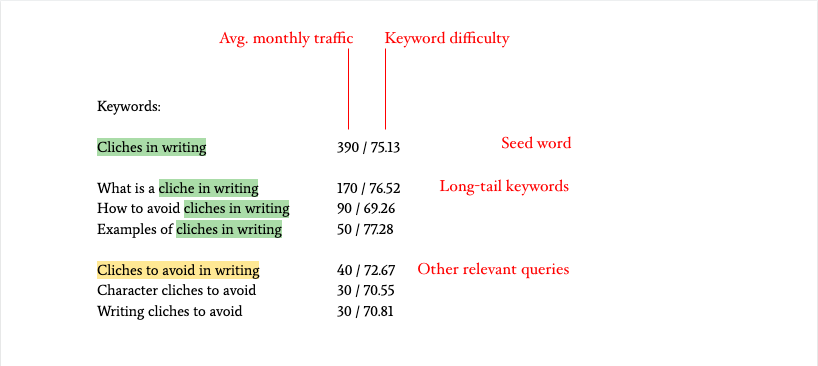
- Seed Word: The primary keyword that the article should target. This keyword should appear in headers and within the text 4-6 times.
- Long-tail Keywords: Longer queries which include the seed word. Each of these queries should also appear in the text 4-6 times.
- Other relevant queries: Search queries which relate to the topic but do not include a seed word. Each of these should appear in the text 1-3 times. These queries usually have less monthly traffic.
- Avg. monthly traffic: The number of people using the keyword each month in search queries. Higher traffic corresponds with more views, though popular queries often have higher KD%.
- Keyword difficulty (KD%): How hard it is to show up in the search results for that specific query. Higher KD% corresponds to more competition. Most writing-related keywords range between 60-80% difficulty.
Here’s what those keywords look like in action. The introduction to an article is often the easiest space to fit keywords in, since introductions involve less specific information. Plus, the earlier a keyword is mentioned in the article, the better an article might perform in searches for that keyword.
Wrapping Up
We’re here to help with these guidelines—especially the SEO side if that’s newer to you—so please be in touch at any time. Thank you!

